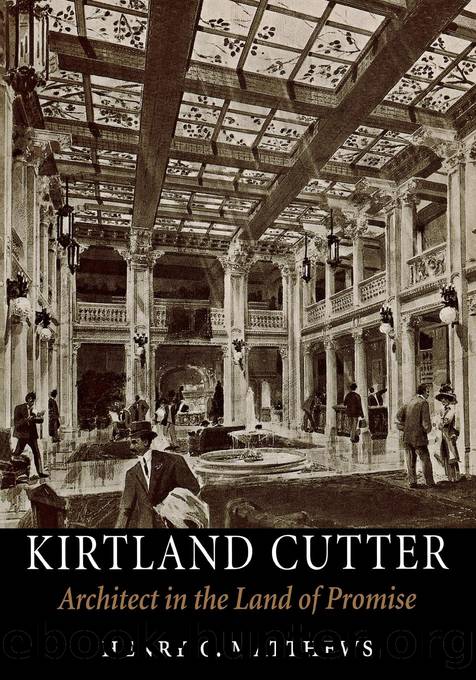Kirtland Cutter by Henry C. Matthews

Author:Henry C. Matthews
Language: eng
Format: epub
Publisher: University of Washington Press
Published: 2017-04-14T16:00:00+00:00
9.14 Swan Lake Camp, 1919â20, section through the great hall. Eastern Washington State Historical Society, L84â207.119.
9.15 Great hall roof structure at Swan Lake Camp. Photo by the author.
This space is hardly cozy. As the name implies, Kelley built it for large gatherings; and here, summer after summer, members of his elite social circle would gather before and after dinner. But the gallery, divided by the structure into three bays, offered an intimate place for private conversation. Around the assembly hall, on a screened porch furnished with large wicker armchairs, guests could relax and gaze through the trees toward the lake. Six bedrooms and four bathrooms for the Kelley family and their most important guests opened onto a courtyard beside the assembly hall. With exposed log walls, handmade rustic furniture, and large fireplaces of locally quarried stone, these rooms carried on the rustic theme. Other guests were accommodated in separate cabins. The dining hall and kitchen were also in a separate structure.
The finest of the areaâs log craftsmen, Ward Whitney and Fred Kitzmiller, constructed the Kootenai Lodge. The work, as it had been for Lake McDonald Lodge, was labor intensive. The logs were felled in the winter and seasoned for a year. During that time they were turned every thirty days to ensure even drying. The most arduous part of the process of preparing the logs was the careful stripping away of the outer layer of bark, leaving intact the dark brown cambium layer.
In the early days, the journey from Butte to Swan Lake, by train, stagecoach, steamer, and finally by wagon along the Swan River, took two or three days. By the time Cutterâs lodge was built, the railway was bringing visitors to Whitefish, where they were met by chauffeur-driven automobiles. The Kelley family and some of their guests traveled in the âAnaconda,â Con Kelleyâs private railroad car. Even so, the attractions of the Kootenai Lodge and its surroundings must have been unusual to entice them all the way from New York. When they arrived, they could combine the simplicity of the forest scene with the sophistication of high society. In the daytime they could ride, swim, hunt, or fish, or relax in the shade of the trees, watching the shifting light on the water. There were plenty of special events, such as picnics and regattas. Guides were available to lead expeditions and initiate urbanites in the fine points of hunting and fishing. In the evenings there were cocktail parties, barbecues, and formal dinners served as elegantly as they might have been on Long Island.
With gardeners, woodcutters, grooms, chauffeurs, night watchmen, and laundresses, there were about seventy employees on the Kelleysâ payroll. The household staff of nine included Thomas Clydesdale, their impeccable Scottish butler, who saw that no luxuries were lacking and made no concessions to the backwoods. Each year he brought the silver chest from New York with fifty place settings. He had tables laid with Wedgwood china, Steuben crystal, and exquisite linen. Dinner was formal and the cuisine outstanding.
Download
This site does not store any files on its server. We only index and link to content provided by other sites. Please contact the content providers to delete copyright contents if any and email us, we'll remove relevant links or contents immediately.
Kathy Andrews Collection by Kathy Andrews(11731)
The remains of the day by Kazuo Ishiguro(8826)
Paper Towns by Green John(5092)
Spare by Prince Harry The Duke of Sussex(5074)
Industrial Automation from Scratch: A hands-on guide to using sensors, actuators, PLCs, HMIs, and SCADA to automate industrial processes by Olushola Akande(4985)
The Body: A Guide for Occupants by Bill Bryson(4975)
Machine Learning at Scale with H2O by Gregory Keys | David Whiting(4185)
Be in a Treehouse by Pete Nelson(3951)
Never by Ken Follett(3794)
Harry Potter and the Goblet Of Fire by J.K. Rowling(3775)
Goodbye Paradise(3728)
Into Thin Air by Jon Krakauer(3313)
The Remains of the Day by Kazuo Ishiguro(3295)
The Cellar by Natasha Preston(3262)
The Genius of Japanese Carpentry by Azby Brown(3226)
Fairy Tale by Stephen King(3220)
120 Days of Sodom by Marquis de Sade(3183)
The Man Who Died Twice by Richard Osman(2997)
Drawing Shortcuts: Developing Quick Drawing Skills Using Today's Technology by Leggitt Jim(2996)
